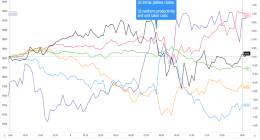It is a common refrain that the Federal Reserve’s numerous tone and policy shifts in 2021 was equivocation—leading to frustration among market participants and business leaders.
But there is another way of looking at how the Fed’s policy makers navigated the year’s turbulent and uncharted waters, as economic and financial-market developments gyrated and morphed daily. In fact, if I had to pick one word to describe the Fed’s strategy over the past year, it would be this: recalibration.
Consider the changing economic worlds the Fed faced as the year progressed:
A gloomy start
U.S. gross domestic product started the year still notably below its pre-pandemic level, and talk of a K-shaped recovery abounded—with winners and losers among households and companies varying according to whether remote work was an option. Labor-market indicators were still abysmal. The threat of labor-market scarring and an erosion of skills for some of the most vulnerable workers loomed.
The promise of vaccines enabling the return to in-person services consumption and turbocharging the recovery provided some hope, but the rollout was in its nascent stages. Meanwhile, consumer-inflation gauges continued to linger 0.4 to 0.5 percentage point below the Fed’s 2% target. The Fed’s broad and inclusive full-employment mandate and flexible average inflation targeting regime were well suited to assisting the recovery against this challenging economic backdrop and subdued inflation.

The rollout of Covid vaccines provided some hope in a gloomy start to the year.
Photo: Micah Green/Bloomberg News
An accelerating recovery
The economic situation shifted dramatically over the course of the year. Congress and the White House delivered two additional rounds of fiscal stimulus in the first quarter. Extending both direct checks to households and federal jobless supports via extended unemployment insurance supercharged goods consumption, even as Covid-19 unknowns and mobility restrictions damped spending on in-person services. Relatedly, rock-bottom mortgage rates, the rise of remote work and millennials getting wealthier combined to fuel housing demand, particularly for moderately priced starter homes.
Then, as the vaccine rollout picked up in the spring, services providers faced a sudden demand surge amid mounting labor shortages and rising commodity prices. Meanwhile, global supply chains remained congested as the pandemic hampered production and transport of goods Americans desired. Importantly, thanks to fiscal supports and the rapid adoption of vaccines, the U.S. economy accelerated from recovery mode back to an expansion, achieving its pre-pandemic GDP level in the second quarter.
Enter inflation
Ultimately, strong demand and constrained supplies collided to produce inflationary pressures seemingly everywhere by the summer and fall. Americans’ desire for goods that can be consumed from home, including high-tech gadgets, automobiles and appliances requiring computer chips stoked prices. So did the fact that these products couldn’t be supplied fast enough as foreign factories struggled with rolling shutdowns and sick workers. Many companies were also forced to pass rising costs for commodities, transportation and labor along to their customers.
Powerful demand for new and existing homes, but a depressed housing stock, on top of spikes in costs for lumber and scarce buildable land, pushed home-price increases to 46-year highs. Meanwhile, rents, which were severely depressed amid the worst of the pandemic, were picking up as young people returned to cities after sheltering with family and some potential home buyers were locked out of the housing market.
Although Fed Chairman Jerome Powell said at the November Federal Open Market Committee news conference that he saw no evidence of a wage-price spiral, it is difficult to imagine that salary increases weren’t filtering down into consumer prices. Notably, the cost of services surged in the spring and early summer before the Delta variant reached U.S. shores. Prices for restaurant visits, airline tickets and hotels went vertical as government lockdowns lifted and increasing vaccine prevalence fueled demand for in-person services.

Strong demand pushed home prices rapidly higher.
Photo: Michelle Gustafson for The Wall Street Journal
The return of labor shortages
Acute labor shortages and “The Great Resignation”—the record numbers of Americans quitting their jobs—are pushing wages higher not only in reopening in-person services sectors but across a swath of industries. A variety of factors are contributing to U.S. labor shortages and surging quit rates, including the residual virus fear-factor, lack of child-care options, early retirements and skills mismatches. Potentially, generous unemployment benefits played a roll in keeping some workers on the sidelines. Employees are also using the pandemic as an opportunity to reassess career goals and seek higher-paying jobs.
As the year closes, the economy is expanding at a healthy clip and labor- market indicators are greatly improved. Pent-up demand for in-person services portends another tailwind for growth. However, wages are rising rapidly, and consumer-inflation gauges are hitting 30-year highs. While federal unemployment supports ended and stimulus checks have dwindled in size, the U.S. could be on the verge of another round of fiscal stimulus next year if the current administration’s social and physical infrastructure policies are implemented. This could result in greater growth—but also more inflation.

Labor shortages are pushing wages higher across a swath of industries.
Photo: Elijah Nouvelage/Bloomberg News
The Fed’s response
Amid a confluence of events not seen in decades, the Fed deployed flexibility as its most potent tool apart from zero-bound rates and quantitative easing.
When the outlook was grim at the beginning of the year, the Fed stood firm on extraordinarily accommodative monetary policy. When the highly transmissible Delta variant began its global march, and millions of Americans remained unemployed, the Fed signaled that it wasn’t even “thinking about thinking about” raising interest rates.
As inflation pressures built up over the summer months the Fed telegraphed in September plans to taper quantitative easing starting in November, while a contingent of Open Market Committee members signed up for a 2022 rate increase. Now that the Fed chairman’s five-point inflation checklist for assessing calm and transitory inflation dynamics—lack of broad-based pressures; lower moves in high-inflation items; low wage pressures; tepid inflation expectations; and long-lasting forces that have kept inflation low globally—continues to be challenged by rising prices and wages, more members are supporting rate increases sooner. Markets are getting the message, and at least three quarter-percentage-point increases are priced for next year.
If the Fed’s policy were still to proactively address threats of faster inflation in the future, then observers could well argue that the Open Market Committee’s stance has been too loose and policy makers too slow to react to rising inflation. However, as the revised dual mandate requires more patience regarding achieving full employment and inflation averaging around the 2% target, one could alternatively argue that the Fed has been keeping pace.
But given increasing inflationary pressures, it makes sense that the Fed is pivoting again, now planning faster easing of pandemic stimulus efforts and signaling the likelihood of three interest-rate increases next year. This is because transitory factors driving inflation, including strong demand for goods, combined with supply-chain and transportation bottlenecks, are lingering for longer than anticipated. Moreover, higher prices associated with labor-market and computer-chip shortages, and elevated energy costs, appear to be more persistent. President Biden’s intention to keep Jerome Powell as Fed chairman likely means continued agility in policy-making.
At each macroeconomic inflection point, the Fed recalibrated its policy to match the occasion. Critics hammered the Fed in the moment for seemingly slow reactions and halting decisions; others lauded the central bank for its cautious flexibility in the face of changing circumstances.

The Easton Town Center mall in Columbus, Ohio. Rising prices have created political pressure about inflation.
Photo: Luke Sharrett/Bloomberg News
Ms. Peterson is chief economist of the Conference Board. She can be reached at [email protected].
Copyright ©2021 Dow Jones & Company, Inc. All Rights Reserved. 87990cbe856818d5eddac44c7b1cdeb8








